Are you a new website, competing with a marketing giant in your industry? They are probably outspending you (and other competitors) on Google Ads and hoovering up all the traffic in organic searches. You’re probably thinking that it’s just not worth doing SEO. How will you compete against these industry giants?
We’ve all been there; but don’t let your biggest competitors scare you away from investing in SEO.
The truth is, if you’re not doing SEO, your audience won’t be able to find you, nor will you be able to compete with the big players. When comparing SEO vs Google Ads, it’s essential to recognize the long-term benefits of SEO. While Google Ads can provide immediate visibility, SEO helps you build organic traffic that lasts.
Keep reading to find out why having big competitors is a good thing and why SEO can help you rank above them. We’ll even demonstrate three SEO tactics to get your pages above the competition, including:
- Tactic #1 – Ethically stealing competitor brand traffic
- Tactic #2 – Ethically stealing competitor keywords
- Tactic #3 – Finding subcategories your competition missed
Each method is crucial to building topical authority and beating industry giants, even if your domain rating (DR) is miles behind theirs.
Identifying Opportunities in SEO
When analysing your online space, you’ll likely see industry giants’ dominating the field. They typically display three things:
- They have substantial domain ratings of 80+
- They are getting a significant amount of traffic from the search engine results pages (SERPs)
- They have some serious brand awareness
When you see a brand achieving this, what does it make you think?
Many worry their businesses don’t measure up. Maybe, you believe you won’t be able to compete in this space because these known brands are taking all the traffic.
It’s not unusual for businesses to see these huge players and get scared they cannot grow. However, what if we told you, this is NOT an indicator to stop SEO efforts? Nor is it a reason to avoid pursuing SEO. In fact, it’s quite the opposite.
If industry giants are dominating the niche, this tells us one very important thing:
There’s an opportunity here.
Redefining competitor traffic as a positive growth indicator
Topical keywords are getting traffic, and the big businesses are getting leads and sales. These indicators mean your company has an opportunity to attract that existing traffic and convert them into paying customers.
This is a far better position than your competitors getting no traffic because that shows there’s not enough demand in your niche. You may notice this happening if you invent a new concept or product.
Suppose you create a product or service that addresses a particular problem. If there isn’t enough demand in the niche, it essentially signifies the number of people seeking a solution to this problem is minimal. When solution traffic is small, it forces you to go to the top of the funnel to find customers.
So, if you’re in a situation where big brands are sucking up all the traffic, it doesn’t mean you can’t access that traffic yourself. Instead, it is a great sign of enough interest in your industry. In fact, even niche industries like vape shops can benefit greatly from targeted SEO efforts. By using vape SEO strategies, businesses can rank higher and tap into this existing demand.
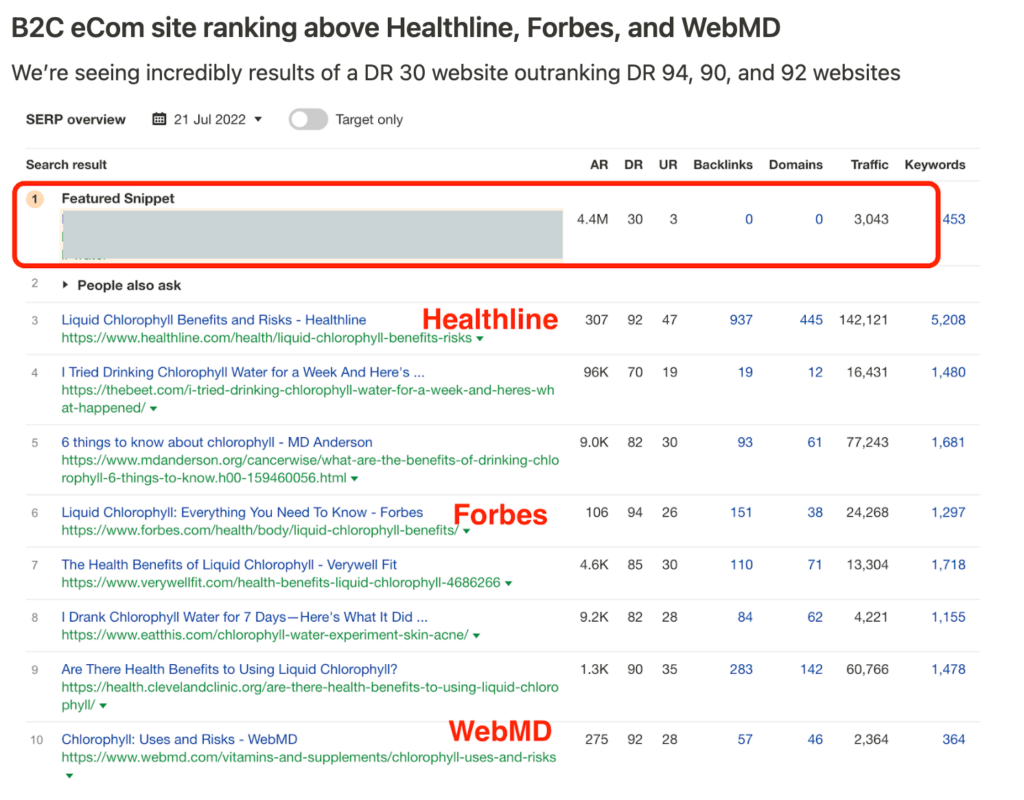
The screenshot above is a pivotal example of our client ranking above their competitors. As you can see, our client has a domain rating of 30 and no direct backlinks to this specific page. This client won the top spot, above the likes of Healthline, Forbes, and WebMD, which have high DRs and numerous direct backlinks to the page.
Clearly, it is possible to get traffic in high-demand keyword areas, even if you’re up against some huge players in the game.
You can look at it as a positive indicator that your niche can support an SEO strategy because large competitor traffic demonstrates where there is a pool of many potential customers.
In the rest of this article, we’ll consider reframing your thinking to an abundance mindset. You’ll see that competitor traffic is an opportunity to grow rather than an indicator to flee.
The 3 Savvy SEO Tactics to Outrank the Giants
Having authority in your digital space is fundamental to ranking well against your competitors. When you demonstrate expertise across the entire topic, Google will perceive your site as an authoritative source. This depth of knowledge is known as topical authority.
Even if your competitors are sucking up the majority of the search traffic, you must remember that there is more to go around. For instance, if a brand takes up ¼ of the traffic volume, there’s still ¾ left. Not to mention hundreds more keywords to target. Attracting more traffic in a popular niche isn’t about winning the top spot in the hardest keyword. Instead, it’s about targeting many keywords with high intent to show Google you have topical authority and rank high in numerous searches.
The following section considers three savvy tactics to outrank industry giants using SEO and to supercharge your topical authority.
Tactic #1 Ethically Stealing Competitor Brand Traffic
One of the ways your competitors are gaining such significant traction in their niche may come down to excellent brand awareness. So, rather than letting this work against you, the first tactic is to set yourself up to appear in searches for competitor brands.
Why would we do this?
The reason is simple. If people know your competitor’s brand as the leader of the industry, you need to be showing up in those searches offering potential customers an alternative to a known name.
Learn how your customers search
Before you start writing or publishing any pages, it’s vital to learn how your customers search. You can ask a new potential customer to research and understand your industry, tasking them with finding a solution to the common problem. This allows you to understand how they use Google to find a solution to their pain points. This is a super interesting place to start because you see the search results and the types of companies coming above your site or solution.
While you may have an idea of who your competitors are from a business model perspective, it’s crucial to repeat this research from an SEO point of view, as the competitor landscapes are very different.
As you continue this research, you need to keep track of the competitors and features that keep appearing in the SERPs. The most recurring of these will define the industry to someone who has never entered this space. A new customer will quickly pick up on which solutions show up first and frequently – these are the ones they usually go for.
Analyse the competitors
Before moving on; it’s vital to complete the previous step. Take the time to understand how your customers search and identify which solutions and features are leading the industry from an SEO perspective.
Now, you can take all the branded keywords and features you identified and put them into an SEO software tool, such as Ahrefs or Semrush. Next, filter for low keyword difficulty.
Rather than focusing on the competitors you think are noteworthy, you need to base this competitor search on the results you found from the customer searches. In doing this, you must ignore everything you know about the industry right now.
Ethically stealing competitor brand traffic: Case study
Let’s look at an example of how this competitor SEO research can develop into an effective strategy for stealing their brand traffic.
In this example, we have Legislate, a contract template company. Below are two examples of how they’ve used this approach effectively.
Example #1:
When Legislate were researching, they found DocuSign was one of the leading players in their industry. Since this brand was getting a good chunk of the traffic volume, they started looking up interesting DocuSign keywords.

As you can see on the screengrab, the DocuSign keyword cluster was relatively easy to compete in. The reason is likely because the searches aren’t very commercially intent; rather they promote brand awareness.
Fortunately for Legislate, they rank relatively high on this page, positioning themselves as an alternative to DocuSign. Their meta tags create doubt about their competitor, suggesting someone should consider other options. Someone searching for a brand like this is typically at the top of the sales funnel, so all you need to do is get inside these searches, present an alternative solution, and suggest that DocuSign isn’t the best option.
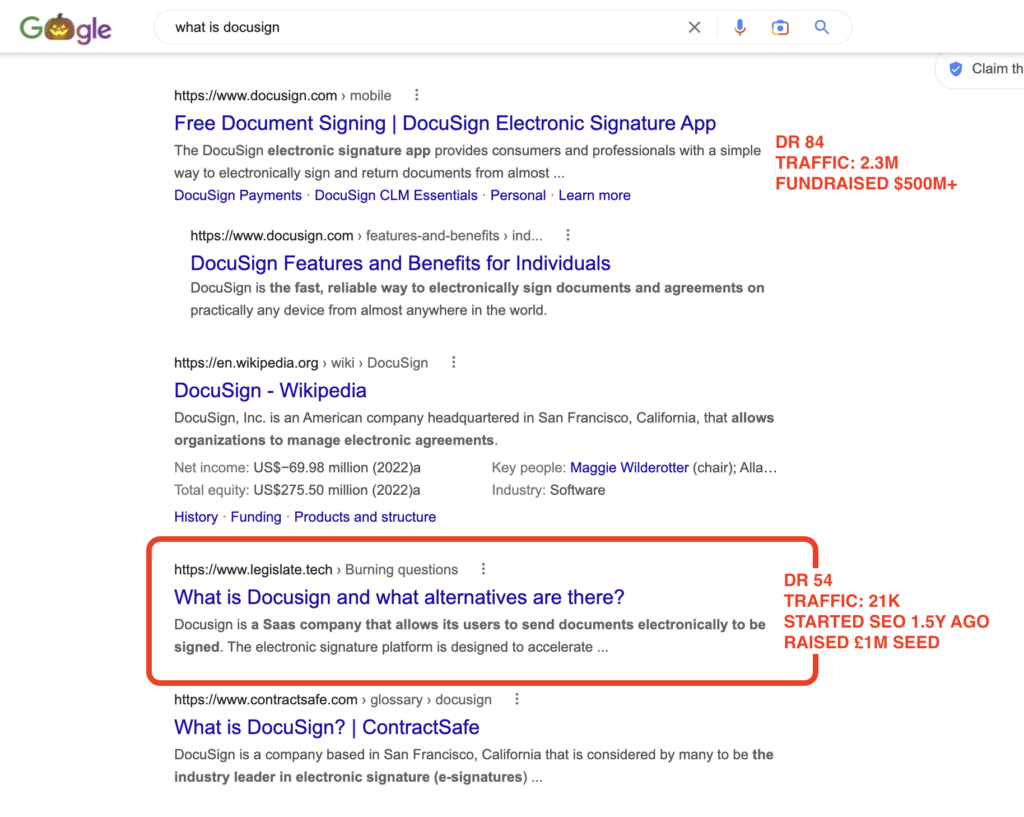
Example #2:
Legislate spotted another opportunity with a high intent cluster based around the term “Whsmith tenancy agreement,” referring to the large UK retail store. Interestingly, it’s a commercially high intent keyword meaning a high percentage of searchers intend to purchase and convert into paying customers – this is known as a bottom-funnel search.
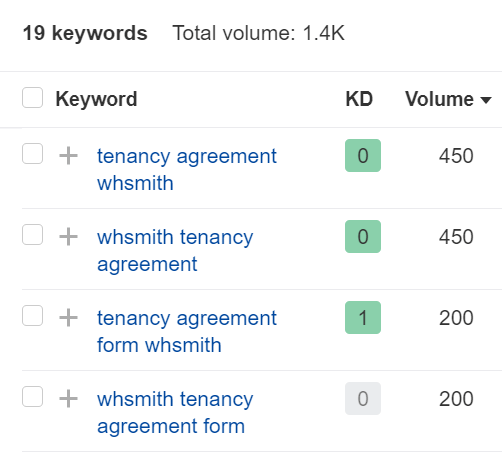
As WHSmith has such a vast presence, Legislate is using these branded keywords that relate to their product, service, or solution and comparing themselves to this competitor. The below screenshot show’s their success targeting these low-volume but high-intent search terms.
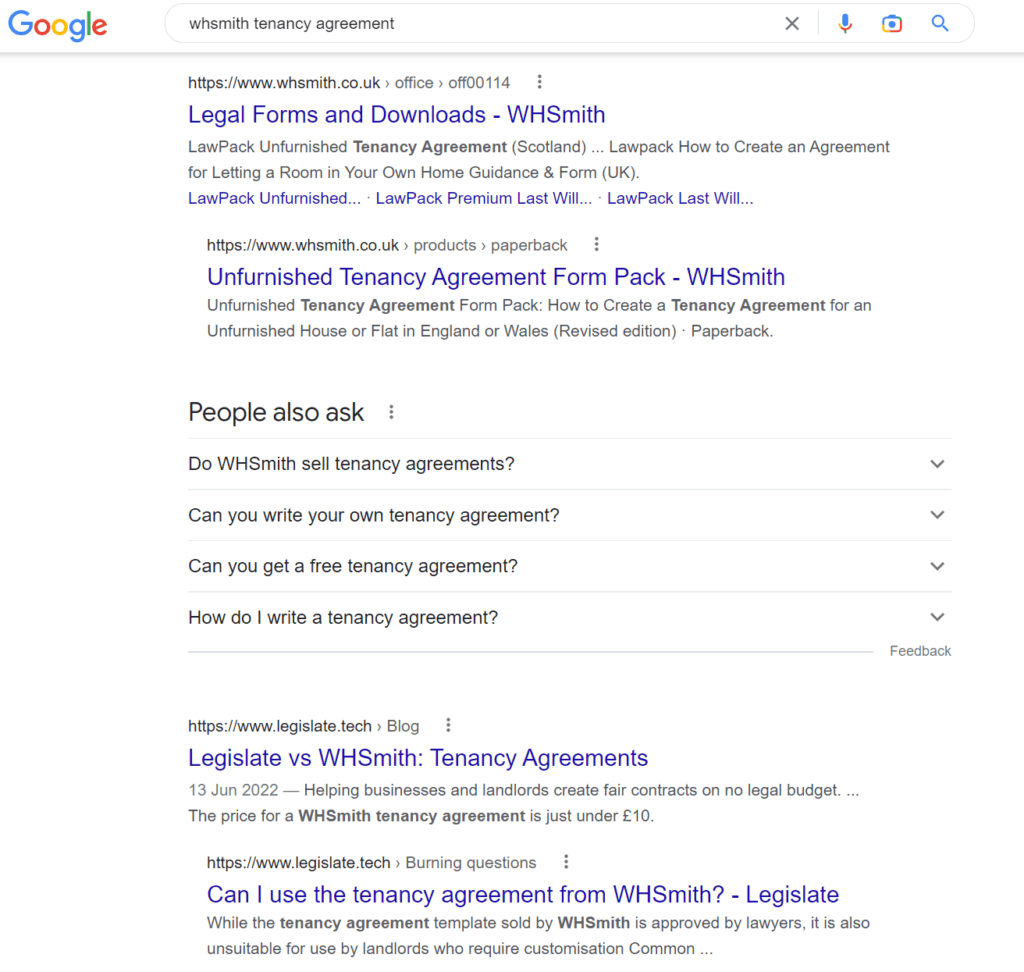
The above two examples are excellent demonstrations of stealing competitor-branded traffic ethically. Legislate have shown they’ve paid attention to how the customer searches, identifying competitors and functions. While some of these tactics build brand awareness, others can convert into bottom-funnel searches and paying customers.
Tactic #1 Cheat Sheet
You can use keyword clusters to create articles or landing pages targeting competitor brand traffic. The following are some great examples of keyword formulas to try out. For example, as Legislate did, you could write a blog page titled ‘Legislate vs. DocuSign: Which is Superior?’ or they might write a landing page about DocuSign Reviews, recommending their own solution. While it may feel counterintuitive to discuss a competitor specifically, customers appreciate that you’re helping them make a decision.
Keyword formulas to try out:
- {{Competitor A}} vs {{Competitor B}}
- {{Competitor}} vs {{Feature}}
- Best {{Feature}} Tool
- What is {{Competitor}}
- {{Competitor}} Pricing
- {{Competitor}} Discount
- {{Competitor}} Reviews
- What is wrong with {{Competitor}}
Tactic #2 Ethically Stealing Competitor Keywords
In essence, stealing competitor keywords means going through your competitor’s pages, identifying which keywords they rank for and which of these you’re not targeting.
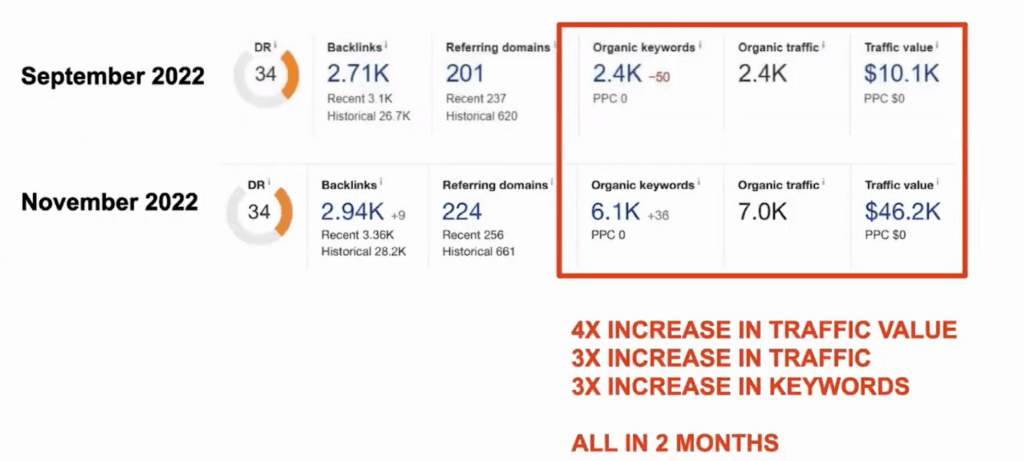
In this case, from September 2022 to November 2022, their traffic value went from $10k per month to $46k per month. These figures mean this brand’s organic traffic is worth the equivalent of paying $46,200 on ads every month. Moreover, their organic traffic increased from 2,400 to 7,000, and organic keywords increased from 2,400 to 6,100.
So, how do you apply this approach to your industry?
Firstly, you should have followed the first tactic and identified those big players in your industry. This step then aims to go through keywords your competitors rank for. By doing this, you’ll be able to highlight content gaps in your own strategy and increase the number of keywords you’re targeting. Here is the low down on stealing competitor keywords ethically:
- Go to ahrefs.com and add your website domain for analysis
- Open 2 tabs → Competing Domains and Content Gap
- Pick a couple of successful competitors from Competing Domains
- Add them to the Content Gap report
- From here, you’ll see a list of keywords your website doesn’t rank for, but your competitors do.
- Filter out irrelevant keywords
- Download the keywords list
- Group them into relevant keywords clusters by search intent
Using your competitors’ success; you can identify where you are missing out on opportunities to grow and rank on Google. From the list of keywords you don’t rank for, you can use these clusters to write super high-quality content increasing traffic and topical authority.
Creating those keyword clusters is crucial to creating informationally complete pages that show off your depth of knowledge in a topic. This is how our client in the previous example 3-4x their organic keywords, traffic, and traffic value in just 2 months.
Doing this tactic can also help you identify your competitors’ sites’ structure and how they approach SEO. For example, some may play off branded keywords, using every single one of their competitors’ brand names to create landing pages. Whereas an eCommerce site might create landing page categories for each term.
Tactic #3 Finding Subcategories Your Competition Missed
Your competitors may be ranking high for some very difficult keywords, but there is an abundance of terms they don’t bother with. It’s impossible to target every single keyword in a category, so naturally, there will be numerous niche search terms and pages that these huge players don’t have.
Before we go into how you can identify these, let’s break down why your competition is leaving so many search terms left untouched. These are some of the reasons why many keywords are left untargeted:
- Low search volume
- Aren’t as impressive on the surface, so decision-makers often don’t see the benefit
- Less obvious
- Blocked by bureaucracy
- Slowed down by tech teams
It’s common for decision makers, such as CEOs, managers, etc., to want the most known keywords in the top 100 niche terms. However, instead of targeting broader keywords like “credit cards,” it’s more efficient to target long-tail terms like “credit cards for freelancers.” Not only is it easier to target and get higher in the SERPs, but it’s a high-intent, specific keyword.
Focusing on long-tail keywords with lower volume but high intent is arguably more beneficial to your business than targeting the overarching topic.
Identifying subcategories your competition missed: Case study
Here are some examples of finding subcategories that your competition has missed. Suppose a hotel is trying to find its competitors’ content gaps. They are facing some huge competition like Booking.com or Kayak.com. However, while they dominate terms like “best hotels in London,” you can work with more specific terms they don’t bother to target. In fact, these often have a better intent and are more likely to lead to purchase.
Instead of using the above example, a hotel might target more specific searches such as:
- Best dog-friendly hotel in {{City}}
- Best hotel in {{City}} for {{Purpose}}
- Hotels in {{District in the City}}
- Hotel near {{popular landmark}}
Moreover, in eCommerce, you can create landing pages and product category pages. For instance, a wedding dress store may create categories based on keywords such as “vintage wedding dresses,” “princess wedding dress,” and so on.
There are numerous ways to target these low-volume keywords, so you might try to watch out for the structures your competitors follow. Here is an example of how you’d find a subcategory for B2B services:
- You have your {{Service name}}
- Go to the Keyword Analysis on ahrefs.com
- Write {{Service Name}} + “for”
- Identify all keywords that follow the pattern {{Service Name}} + for + {{Client Type}}
- Example: PPC services for eCommerce
- Example: Law service for small business
- Create clusters by grouping keywords by search intent
- Develop landing pages for each group

Final Takeaway
If you started reading this piece believing it was impossible to outrank a DR 80+ site; hopefully, you now understand it is possible. The three tactics above build topical authority, improving your chances of creating content that wins the top spots in SERPs.
By ethically hijacking competitor brand traffic and appearing in search results as a viable alternative, you’re taking the first step to improving brand awareness and taking some traffic flow away from big competitors.
Beyond this, outranking industry giants means identifying and addressing content gaps in your SEO strategy and your competition’s.
However, it’s important to know how your potential customers use Google first, so you know which competitors and features to be aware of. Finally, you should do all three of these tactics in this order to ensure you’re building topical authority and not missing out on vital growth opportunities.



